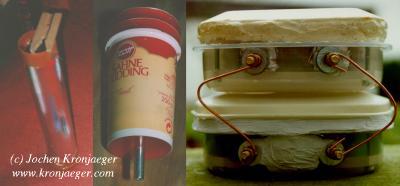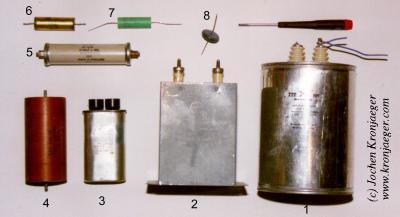| Jochen's High Voltage Page |
Capacitors are very simple devices in principle. All that´s needed is two conducting surfaces and something non-conducting (the so-called dielectric) in between. It´s possible to make a cap from aluminum foil and a glass plate, a plastic tube, a ceramic tile etc. The following points should be taken into account when constructing or chosing a cap:

|
Some examples that I have tried (which does not mean that these are optimal designs!). From left to right (click links to get more details of construction):
|
Another easy-to-make type are so-called salt-water caps. These consist of a plastic or glass bottle, filled with highly concentrated salt solution, and covered with aluminum foil on the outside. The salt solution acts as the inner conducting surface. A layer of oil on the salt water filling prevents corona. Obviously, such caps are relatively large and heavy compared to their capacitance.
The capacitance of a homebrew cap can be calculated using the formula below. In this formula, the plate surface area is the total active area, i.e. if the cap consists of several layers, say N dielectric layers between N+1 conducting layers, the total active area is N times the surface area of one conducting layer.

The relative dielectric constant is a property of the dielectric material. It is 1.0 for air and around 2.0 for many plastics, but can be as high as 1000 or more for certain ceramics. As a rule of thumb, two parallel conducting plates separated by 1mm air have about 1pF capacity per square cm area.
Every pair of conducting bodies separated by a medium such that the two bodies may have different potentials acts as a capacitor. In particular, any conducting body has a capacitance against ground (floor, walls, etc.). As an example, the capacitance of a conducting sphere is about 1pF per cm radius. This fact is of particular importance for tesla coils, where the capacitance of the toroid reduces the resonant frequency of the secondary coil.
Commercial caps can often be bought as surplus and are sometimes quite cheap. However, most of the surplus caps (MKT, oil+paper) are not suitable for tesla coil or extreme pulse discharge use. Specifically for this purpose there is now the MMC (multi mini cap) technique, which simply means putting many small commercial caps (PP dielectric, rated e.g. 33nF/2kV) in series and parallel to achive the necessary capacitance and voltage rating.

|
Commercial capacitors. (1) 60uF/2.5kV and (2) 4uF/3.2kV both oil-filled, (3) 1uF/2kV from microwave oven, (4) and (5) oil+paper caps ca. 10nF/10kV, (6) and (7) MKT-type foil caps ca. 3nF/10kV, (8) ceramic cap 2nF/10kV. Large version |
| [Index] | [Links] |
This document is copyrighted. All rights reserved. No part of this document may be reproduced without my permission. Permission to copy and publish this document or parts of it on the WWW is granted until explicitely revoked, under the condition that it is accompanied by this or a simliar copyright notice, including my name and the original URL.